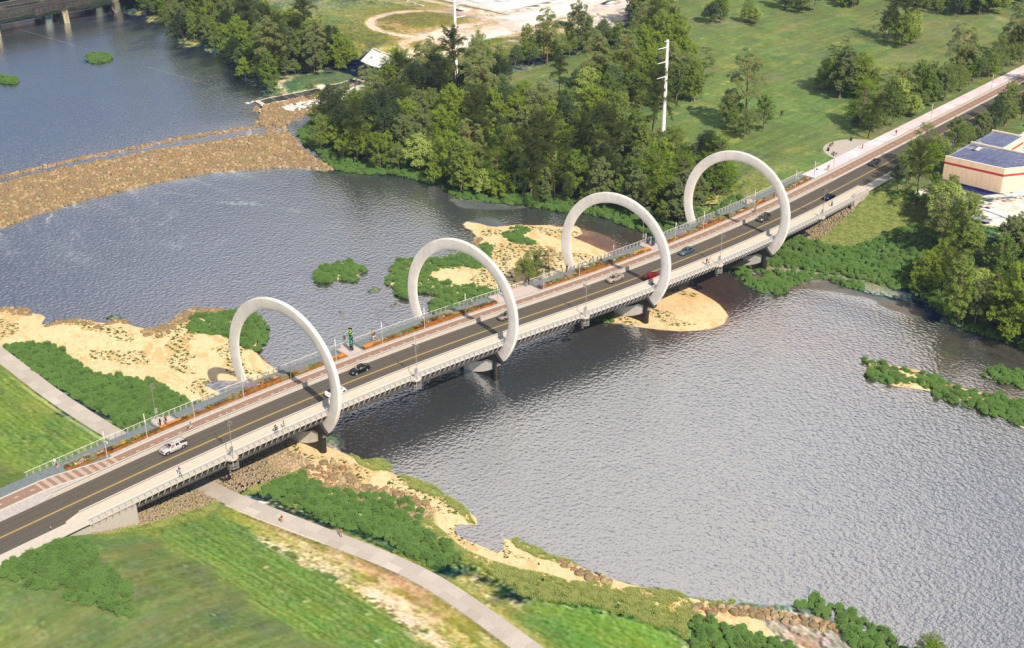Subscriber Benefit
As a subscriber you can listen to articles at work, in the car, or while you work out. Subscribe NowContractors for the city of Indianapolis on Tuesday submitted an archaeological plan for the Henry Street Bridge construction project, which is taking place on land where some of the city’s earliest settlers were buried.
The archaeological plan was submitted to the Indiana Department of Natural Resources Department of Historic Preservation as part of required reporting for development on a former burial ground.
Planners estimate the site could be ready for actual construction by the end of April 2025 if all goes as expected.
The bridge is part of a state-local partnership to develop a major business park on the west side of the White River, an effort that has been complicated by the planned excavation of the historic cemetery on the east side.
The construction team began this week clearing vegetation ahead of a planned mid-October start on the excavation of remains and artifacts. In a news release Tuesday, the Indianapolis Department of Public Works said a contractor discovered some human remains last month during preconstruction work.
Canadian engineering firm Stantec, the contractor on the project’s archaeological work, collected 10 corings at the site in August. The process of coring involves pushing 1.5-inch cores to a depth of 25 to 30 feet into the soil. Of those corings, spread across the city’s 1.38-acre project site, two showed evidence of human remains. It is estimated the remains were six to 10 feet below the ground’s surface.
Workers notified state and local authorities, as required by state law. The DPW said it was “committed to going above and beyond” what is required by state law in coordination with the Community Advisory Group, or CAG, that was established to make recommendations about the site.
City officials have previously estimated that 650 or more graves could be unearthed during the construction of the bridge project. Proper excavation and resettlement of the remains was expected to cost upward of $12 million.
“The city and our team of archaeologists are committed to being transparent about our findings,” DPW Director Brandon Herget wrote in a statement. “We recognize these remains may be two of many individuals who may be buried near the construction site. The intent of this announcement is to continue our commitment to both the CAG and the broader community to be transparent about our process and discovery in this historic area of our city.”
The city finalized a contract with Stantec in late June. At that same time, officials shared intentions to change course at a public meeting. Whereas the city formerly worked on the site and dealt with remains as they were discovered, the strategy now calls for a total excavation of the site and a search for remains before the construction process for the eastern portion of the bridge project begins.
According to a copy of Stantec’s work plan provided to IBJ, the firm discovered the remains near the western edge of the worksite. Stantec also notes that construction workers at the nearby former Diamond Chain site also have discovered human remains during excavation work.
The document submitted to the Indiana Department of Natural Resources has not been approved by the state governing body and could change. Generally, it lays out a proposed timeline and method.
On Monday, the construction team began clearing vegetation along the east bank of the White River. An archaeologist will be on-site to monitor that work, according to the DPW.
In mid-October, Stantec plans to begin mechanical stripping. Mechanical stripping is a process in which heavy machinery removes the top layer of soil at a site to reveal archaeological features. Machinery will go to a depth of between 3.5 feet to 7.5 feet to remove additional dirt that has collected atop potential remains. Researchers are able to identify depths based on soil stratification in cores.
On or around Nov. 1, Stantec anticipates the first stage of excavation will be complete. Next, an archaeological team will monitor backhoe stripping of the cemetery portion using a smooth blade backhoe. On-site archaeologists will identify and map any grave shafts. Those experts will uncover remains by hand using wooden tools and mesh screens. They will also be responsible for photographing and documenting details regarding human remains and artifacts as they are found using iPads.
Following excavation, remains and artifacts will be analyzed. Stantec does not include a target date for that process.
Human remains will be carefully removed and transferred to a secure facility for documentation and analysis. University of Indianapolis bioarchaeologist Jeremy Wilson will lead that process. Stantec will take any artifacts to its project laboratory for analysis and they will later be buried with the grave shaft in which they are found.
The location and methods of reinterment—or the process of re-burying remains—will be determined after skeletal and artifact analyses are completed.
Stantec aims to submit a management summary to the state Department of Natural Resources around April 4, 2025. That date is meant to represent five weeks before the completion of excavation. By April 25, 2025, Stantec estimates that the state Department of Natural Resources will have approved the site for construction.
Within a year of excavation completion, Stantec will be expected to submit a final report on the project to the DNR.
Please enable JavaScript to view this content.


Correction: Jeremy Wilson is at IU Indianapolis, not the University of Indianapolis.